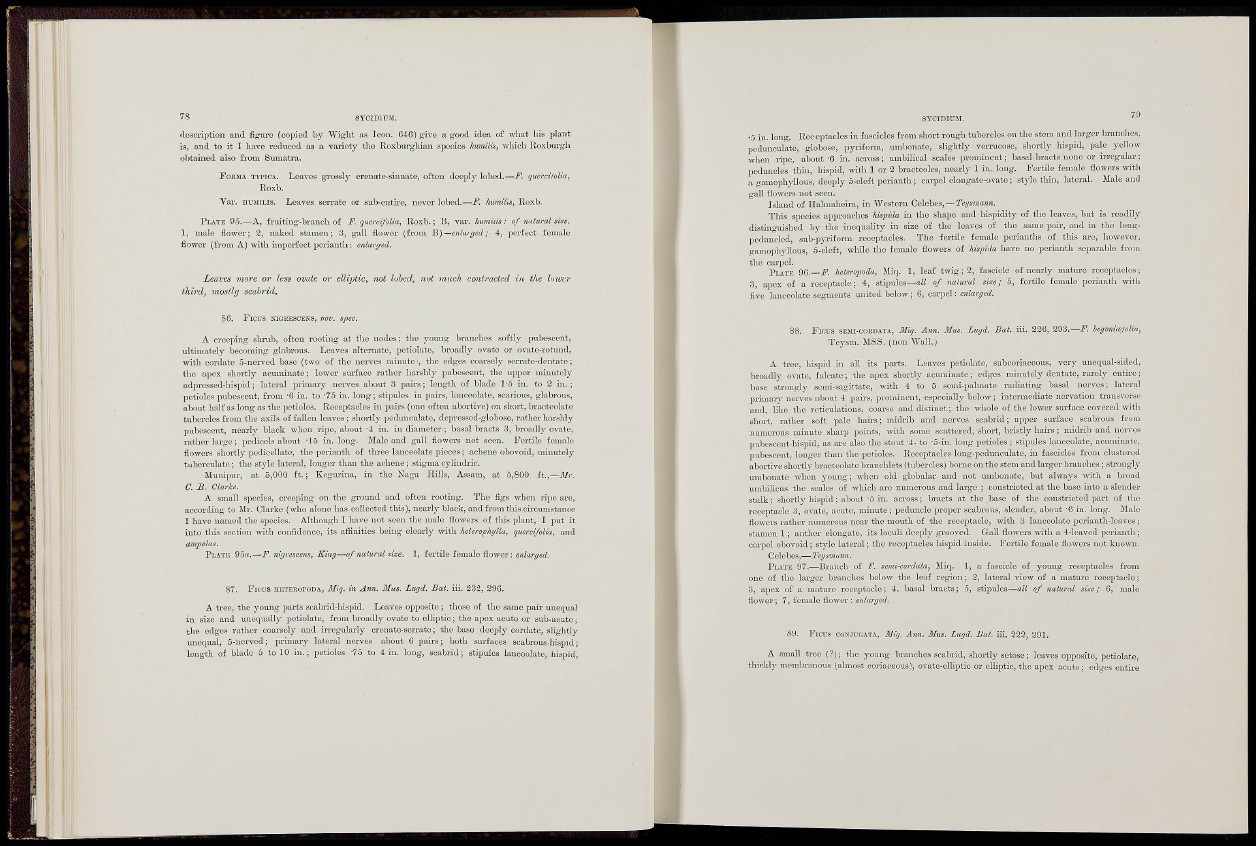
78 SYCIDITJM.
description and figure (copied by "Wiglit a« Icon. 640) give a g-ood idea of what liis plant
is, and to it I have reduced as a vaiiety the Roxburgliian spccics humiliH, -which Roxbui-gh
obtained also from Sumatra.
FOEMA TYPICA. Leaves grossly creuatc-sinuate, often deeply lobed.—F. querei/oUa,
Roxb.
Var. HusfiLis. Leaves serrate or sub-entii-e, never lobed.—F. humiUs, Roxb.
PLATE 95.—A, fniiting'-branch of F. qum-cifolia, Roxb.; B, var. humiiis: of natural size.
1, male iiower; 2, naked stamen; 3, gall flower (from ii)—ciiluir/ed; 4, perfect female
flower (from A) with imperfect perianth: enlarged.
! more or less ovale or elliptic, not hbed, not much contracted m the lower
third, mostly scabrid.
S6. Ficus NIGEESCEN9, nov. spec.
A creeping slinib, often rooting at the nodes; the young branches softly pubescent,
ultimately becoming glabrous. Leaves alternate, petiolate, broadly ovate or ovate-rotund,
•with cordato 5-nerved base (two of the nerves minute', tlie edges coarsely sen-ate-dentate;
the apex shortly acuminate; lower sm-face rather harshly piibescent, the upper minutely
odpressed-hispid; lateral primary nerves about 3 pairs; length of blade 1 -5 in. to 2 in. ;
petioles pubescent; from -6 in. to -lb in. long; stipules in pairs, lanceolate, scarious, glabrous,
about half as long as the petioles. Receptacles in paii-s (one often abortive) on short, bracteohite
tubercles from the axils of fallen leaves; shortly pedunculate, deijressed-giobose, rather harshly
pubescent, nearly black when ripe, about -4 in. in diameter; basal bracts 3, broadly ovate,
rather large; pedicels about -15 in. long. Male and gall flowei-s not seen. Fertile female
flowers shortly pedicellate, the perianth of tlu-ee lanceolate pieces; achene obovoid, minutely
tuberculate; the style lateral, longer than the achene; stigmacylindiic.
Munipm-, at 5,000 ft.; Keguiina, in the Naga Hills, Assam, at o,S00 h.,—Mr.
C. B. Clarice.
A small species, creeping on the gi-ound and often rooting. The figs when ripe are,
according to Mr. Clarke (who alone has collected this), nearly black, and from tliis circumstance
I have named the species. Although I have not seen the male flowers of this plant, I put it
into tliis section with confidence, its affinities being dearly with heferophi/lla, quercifoUa, and
PLATE 9oa,—F. nigrcscens, King—of natural nize. 1, fertile female flower: enlarged.
87. Ficus HETEEOPODA, Miq. in Ann. Mas. Lugd. Bat. i 32, 296.
A tree, the young parts scabrid-hispid. Leaves opposite; those of the same pair unequal
in size and unequally petiolate, from broadly ovate to elliptic; the apex acute or sub-acute;
the edges rather coarsely and irregularly crenate-serrate; the base deeply cordate, slightly
imequal, 5-uei-ved; primaiy lateral nerves about 6 paii-s; both sui-faces scabrous-hispid;
length of blade 5 to 10 in.; petioles '75 to 4 in. long, scabrid; stipules lanceolate^ hispid,
•5 in. long, Receptacles in fascicles from short rough tubercles on the stem and larger branches,
pedunculate, globose, pyriform, umbonate, slightly veiTucose, shortly hispid, pale yellow
when ripe, about -6 in. across; umbilical scales prominent; basal bracts none or irregular;
peduncles thin, hispid, with 1 or 2 bracteoles, nearly 1 in. long. Fertile female flowers witli
a gamophyllous, deeply 5-cIeft perianth; carpel elongate-ovate; style thin, lateral. Male and
gall flowers not seen.
Island of Halmaheii-a, in Western Celebes,—rci/smaraM.
This species approaches liisfida in the shape and Hspidity of the leaves, but is readily
distinguished by the inequaKty in size of the leaves of the same pair, and in the longpeduncled,
sub-pyi-iform receptacles. The fertile female perianths of this are, however,
gamophyllous, 5-cleft, wliile the female flowers of hisinda have no perianth separable from
the carpel.
PLATii 96.—J?, heteropoda, Miq. 1, leaf twig; 2, fascicle of nearly mature receptacles;
3, apex of a receptacle; 4, stipules—aZ/ of natural size; o, fertile female perianth with
flve lanceolate segments united below ; 6, carpel: enlarged.
88. Fious SEMI-COEDATA, Miq. Ann. Mus. Lugd. Bat. iii. 226, 293.—legonioijolia,
Teysm. MSS. (non Wall.j
A tree, hispid in all its parts. Leaves petiolate, subcoriaceous, very unequal-sided,
broadly ovate, falcate; the apex shortly acinninate; edges minutely dentate, rarely entire;
base strongly semi-sagittate, with 4 to 5 semi-palmate radiating basal nerves; lateral
primary nerves about 4 pan-s, prominent, especially below; intermediate nervation transverse
and, like the reticulations, coarse and distinct; the whole of the lower surface covered with
short, rather soft pale han-s; michib and nerves scabrid; upper surface scabrous from
numerous minute shai'p points, with some scattered, short, bristly hairs; midrib and nerves
pubescent-hispid, as are also the stout-4- to -o-in. long petioles ; stipules lanceolate, acuminate,
pubescent, longer than the petioles. Receptacles long-pedunculate, in fascicles from clustered
aboi-tive shortly bracteolate branchlets (tubercles) borne on the stem and larger branches; strongly
umbonate when young; when old globular and not umbonate, but always with a broad
umbilicus the scales of which are numerous and large ; constricted at the base into a slender
stalk; shortly hispid; about-0 in. across; bracts at the base of the constricted part of the
receptacle 3, ovate, acute, minute; pcduncle proper scabrous, slender, about -6 in. long. Male
flowers rather numerous near the mouth of the receptacle, with 3 lanceolate perianth-leaves;
stamen 1; anther elongate, its loculi deeply grooved. Gall flowers with a 4-leavcd perianth ;
cai'pel obovoid; style lateral; the receptacles hispid inside. Fertile female flowers not known.
Celebes,—Tegsmunn.
PLATE 97.—Branch of F. sejni-cordaia, Miq. 1, a fascicle of young receptacles from
one of the larger branches below the leaf region; 2, lateral view of a matm-e receptacle;
3. apex of a mature receptacle; 4, basal bracts; 5, stipules—all of natural size; 6, male
flower; 7, female flower : enlarged.
89. FICUS CONJUGATA, Miq. Ann. Mus. Lugd. Bat. iii. 228, 291.
A small tree (?); the young branches scabrid, shortly setose; leaves opposite, petiolate,
thickly membranous (almost coriaceous), ovate-elliptic or elliptic, the apex acute; edges entire